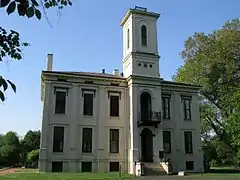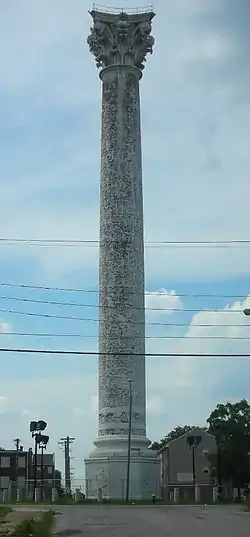George I. Barnett
George Ingham Barnett (1815–1898) was an architect from St. Louis, MO. He was called The Dean of St. Louis Architecture for his contributions to the buildings of St. Louis as well as for his influence on other architects in the United States.[2]
George I. Barnett | |
|---|---|
 | |
| Born | George Ingham Barnett 1815 Nottingham, England |
| Died | December 30, 1898[1] St. Louis, Missouri, U.S. |
| Nationality | American |
| Occupation | Architect |
| Buildings | Missouri Governor's Mansion, Tower Grove House, Henry Shaw Mausoleum |
Early life in England
Barnett was born in Nottingham, England. He completed a classical education by the age of 16, then trained with Sir Thomas Hine at a builder in Nottingham, and then took on an apprenticeship with an architectural firm in London. Barnett left England for the United States in early 1839, remaining in New York City for six months before departing for St. Louis.[3]
Work in St. Louis and Illinois
Barnett designed hundreds of buildings in St. Louis, many in Greek Revival, Italianate, and Gothic design. Barnett did not deviate from classical designs, and his portfolio was largely responsible for establishing Classicism as St. Louis' dominant architectural influence.[4] His works included houses, churches, commercial, and civic structures. Among his best known structures are renovations to the Old Courthouse, the Missouri Governor's mansion, the structures of the Missouri Botanical Garden, Tower Grove Park, and the Southern Hotel.[5] The Samuel Moody Grubbs House in LItchfield Illinois. The only structure in Illinois he designed. It is a second Empire design.
 Tower Grove House, 1849
Tower Grove House, 1849 Old Courthouse, completed 1864
Old Courthouse, completed 1864 Grand Avenue Water Tower, 1871
Grand Avenue Water Tower, 1871
 Tower Grove Park, 1875
Tower Grove Park, 1875 Henry Shaw Mausoleum, 1889
Henry Shaw Mausoleum, 1889
Influence on other architects
Barnett's son, Thomas P. Barnett, trained with the elder Barnett and went on to design such American landmarks as the Cathedral Basilica of St. Louis and the Adolphus Hotel in Dallas. His other son, George D. Barnett, and his son-in-law, John Ignatius Haynes, joined Tom Barnett to form the architectural firm of Barnett, Haynes & Barnett.[6] His eldest son, Absalom J. Barnett, became a successful architect in San Francisco.
Other notable architects who apprenticed under Barnett included Henry G. Isaacs, Alfred H. Piquenard, Charles F. May, William Kirchner, Isaac Taylor, and George Strafford Mills.[7]
References
- American Art Annual, Volume 2. American Federation of Arts. 1899. p. 82.
- Sharoff, Robert. American City, St. Louis Architecture, Three Centuries of Classic Design. The Images Publishing Group, 2010, p. xi
- Hyde, William & Conard, Howard Louis. Encyclopedia of the History of St. Louis. The Southern History Company, 1899.
- Sharoff, Robert. American City, St. Louis Architecture, Three Centuries of Classic Design. The Images Publishing Group, 2010, p. xi
- Sharoff, Robert. American City, St. Louis Architecture, Three Centuries of Classic Design. The Images Publishing Group, 2010, p. xi
- Leonard, John W. The Book of St. Louisans. The St. Louis Republic, 1906, p. 38.
- Hyde, William & Conard, Howard Louis. Encyclopedia of the History of St. Louis. The Southern History Company, 1899.